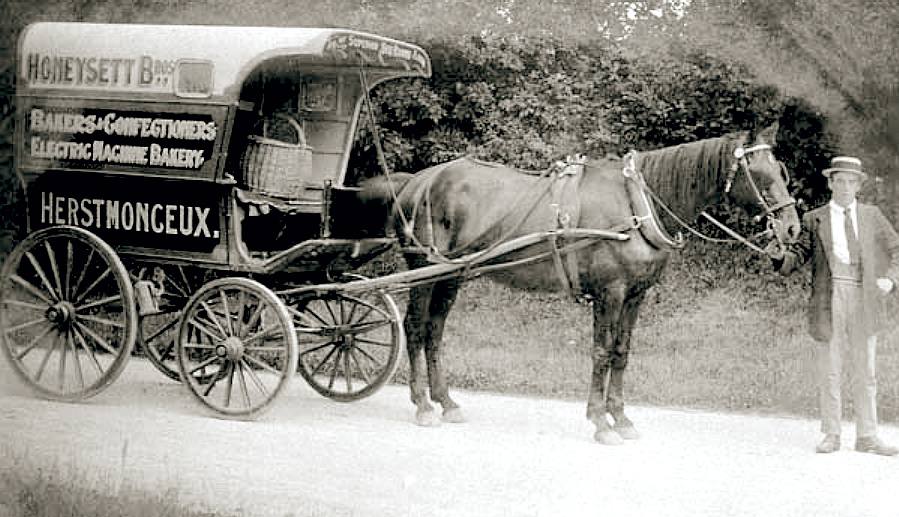|
RAYMOND P. DANNREUTHER
|
|||||||||||||||||||||||||||||||||||||||||||||||||||||||||||||||||||||||||||||||||||
|
R. P. DANNREUTHER - This is a photograph of the Inspector for the Secretary of State who, it appears, was duped by council officers in 1987 into believing that the generating buildings were constructed during the Second World War of corrugated iron. Raymond Portal Dannreuther was invited to believe that the original wooden construction from the turn of the century had been demolished during hostilities to build a hospital for wounded airmen. He did not declare an interest, in knowing the occupier of The Old Rectory, one Peter Townley (see below), but it appears to us from them living just a few miles apart and both being ex-servicemen and attending the same RN events, that there may well have been a liaison. If that was the case, and we'll probably never be able to prove to a criminal standard where the truth of the matter went to the grave with RPD, then such matter would have been very serious indeed. In 2018 Peter Townley is around 95 years old. No use then raking up the past, save for efforts to recognise the historic asset in question.
This page is about Raymond Dannreuther's involvement in a planning appeal where he was appointed by the Secretary of State to preside over a Public Inquiry that was held at Wealden District Council's offices in Hailsham in 1987. The mechanism for appointing Inspectors is a bit like the appointment of judges in criminal cases: shrouded in secrecy and carefully managed.
It is doubtful that any masonic links existed between the occupiers of Lime Park at that time, but with the high level of members of this secret society known to exist in the judicial system, to include the CPS and high ranking police officers; we cannot rule out such influence. We say this because we cannot understand how it was that Dannreuther failed to notice that the extant concrete mounts and north facing wall were obviously original and tied in with the open roof trusses and floor slabs.
The old generating buildings just outside Herstmonceux were purchased in 1981 along with number 4 Lime Park, by Nikolia and Clare Askaroff, members of the Eastbourne family that was well known for making disabled aids and nursery equipment as Simplantex Ltd. The objective of the purchase was to start a family and that the couple managed quite well before separating. The generating buildings were on the opposite side of Lime Park to number 4 and were considered to be a liability by Nik and Clare that would be best disposed of to stem unnecessary expenditure on upkeep or demolition.
THE BARNHOUSE APPEAL 1986/87 (AKA: OAKWOOD OR OLD STEAM HOUSE)
Wealden District Council served an Enforcement Notice on the then occupier in 1986. Service was effected by an agent in person where previous notices were not served correctly. Indeed, this is one of the main features of the Council concerned: a history of defective service. The method of service is important, where public money was spent to personally hand a document to the occupier, but no effort at all was expended on identifying who owned other parcels of land some of which were included in the notice, but that the Land Registry showed as not belonging to the then occupier.
If you are not familiar with appeals, we should mention that the person served has 28 days in which to lodge an appeal with the Secretary of State and one of the grounds of appeal is use for more than four years before the date of service as a dwellinghouse. This is known as the "Four Year Rule." The rush to serve within 4 years despite not taking the time to make the proper enquiries, might explain why Wealden could not spare the time to follow the correct procedure.
T/APP/C1435/C/86/1660/P6
This appeal was dealt with by the Department of the Environment and Transport under the provisions of the Town and Country Planning Act 1971, Section 88 and Schedule 9.
The resulting Enforcement Notice from 1986 was then and is now a nullity where no notice was served on the then owners of a substantial section of land to the north of the old generating buildings that is believed to have belonged to Wickens Estates Ltd, the then owners of the Lime Park service road, or if Wickens Estates had disposed of their interest (unknown and unlikely but a slight possibility) to the owner of number 4 Lime Park.
Equally, no notice was served in respect of land to the front and side on the appeal site that was limited to the generating building dating from C.1900 and a portion of a coal bunker. The defective plans were signed (and presumably) prepared by K. (Kenneth) Wilson, the first chief executive officer of Wealden District Council. An accurate site plan clearly identifying buildings or other items the subject of complaint, must accompany any Enforcement Notice.
The importance of correct service was explained by Vic Scarpa and Geoffrey Johnson to members of the various planning committees in other cases that we have read of and have copies of correspondence relating thereto. In these cases the officers of this Council were doing their best to impede certain applications. In cases where the same officers wanted development or decisions relating to development to proceed, they sometimes overlooked Non-Service issues despite knowing that any decision reached would be void if challenged. They, in effect, gambled that no challenge would be forthcoming, a dangerous and administratively negligent approach sometimes adopted by corrupt council officials.
This serious non-service omission, could and cannot be be rectified, rendering the whole proceedings an abuse of process and ultra vires. It remains to be seen if this Council show any remorse for their negligent case handling and apparent victimization of the then occupier.
NO DEMONSTRABLE HARM
One possible reason that this Council took so long with their service is that during several visits by Thomas William Hoy, he could not find any sleeping arrangements within the generating buildings. The reason for this is that sleeping accommodation was not in the main buildings, but in a World War Two bomb shelter some yards north. By the time [John] Thomas had found that unit, this council were already into their 3rd year of secret committee meetings, having served a Tree Preservation Notice and held an appeal, where several dangerous trees were removed.
The Bomb Shelter was tucked into a hillside and for this reason caused no visual loss of amenity. In their haste to include the bomb shelter, the plans team, or maybe Tom's instructions were not clear - who knows why - plotted the bomb shelter in the wrong place, mistaking an old coal bunker from 1900 for the WWII unit from 1939. Both the bomb shelter and the coal bunker were on land not belonging to the occupier, as was a third underground structure also dating from 1900 - and also converted for use as accommodation with bunks installed.
BABE IN THE WOODS
The then appellant was completely untrained in planning matters and could not afford to employ a specialist. The council's officers were well aware of this and pushed home their advantage, knowing that they would not be challenged as to Government Circulars that he could not possibly know about, nor the defective notice. The failure of this Council to follow the correct procedures meant that the County Archaeologist and/or English Heritage were not consulted by this Council.
This Council employed the same tactics in a later appeal in 1997, meaning that the failure to make the proper enquires was no accident - but rather a deliberate effort to keep the Department of the Environment Inspectors under informed. This Council concentrated on all other aspects of the case, mainly on destroying the character of the appellant, where that is not a material planning consideration, so introducing Article 14 discrimination into the planning arena, where under the European Communities Act 1972, European law is brought into English law - hence - Article 14 violations was then as much a crime as it is today under Section 6 of the Human Rights Act 1998.
MODUS OPERANDI
This Council is and was well versed in the ways that one might disadvantage an appellant. In the Bushywood appeal against demolition they served documents in winter just before the Christmas holidays knowing that the appellant's Michael and Valerie Punter were away. Wealden's nice officers left the enforcement notice outside on a snow covered step. They also left service of their documents to just a few days before the appeal hearing, but this very naughty tactic landed their Council with a costs award for conduct unbecoming members of the RTPI. Such is the moral standard of Wealden District Council. They are no doubt ashamed of their actions, but we think more likely only because they are embarrassed that they were found out - and that is only because of the fact that their wrongdoing is published on this website for all to see. In days gone by nobody knew about such goings on and that is probably why this Council (and no doubt others) carried on as they did. For this reason, if your council is behaving badly, put up the details on a website. You'll be doing Britain a favour - as it might deter other degenerates from doing the same.
DECEPTION
George White and Thomas Hoy pressed home their plan (conspiracy) to fool Raymond Dannreuther on the site visit by distracting the Inspector, keeping him occupied looking at everything but the actual framework of the building. He was not shown the evidence that the iron cladding was a later addition, or questions might have been asked. One point that is unclear is how White managed to explain away the large concrete generator mountings in what is now referred to as Phase B of the generating buildings.
The fact the council officers persuaded Inspector Dannruether that he was considering just a large tin covered shed and not the generating buildings also invalidates the decision he reached, because he was considering the wrong information, rendering his decision (for the Secretary of State) ultra vires. This was decided in the High Court in the valuable case precedent set by Canterbury City Council V Spring Image Ltd 1991. Raymond Dannreuther was not just considering the wrong information, he was deliberately and skillfully being fed a distorted interpretation of the extant buildings.
The fact that this Council used the same tactics again in 1997 for another appeal before Raymond Michael and again in 1998 (Roy Martin as chairman) and 2000 (Colonel Brian Hubbard as chairman) when the then members of the Area Plans South sub committee were to decide negatively - now confronted with the true history from independent experts - but then not to even consider the correct history because of the identity of the applicant, renders Wealden's conduct malicious beyond any reasonable doubt, rather than simple misfeasance in public office.
The introduction of the identity of the applicant and the past enforcement history based on George White and Kenneth Wilson's agenda, clearly makes this a case of institutionalised discrimination, very much along the lines of the Kelly Davis case involving Wansdyke District Council. The discrimination and targeting also involved Sussex Police who adopted a similar approach and aided and abetted Wealden directly in avoiding discovery and prosecution of this Council's officers during the Petition charade.
HERSTMONCEUX (VIRTUAL) MUSEUM
As a result of Mr Dannreuther being fooled by George White, Thomas Hoy and Richard Mercer in January of 1987, the old generating buildings would have to wait until 1999 when an independent archaeological survey revealed that these are the original wooden structures from C. 1909. Wealden's officers embarked on a conspiracy to hide the truth and deprive the then occupier, Nelson Kruschandl, of his home. The objective appears to have been to obtain (unlawfully procure) the property at an undervalue for near neighbours. Other officers involved in this malfeasance in public office included David Laurence Phillips, Douglas Moss, Christine Nuttall, Ian Kay and Victorio Scarpa.
The
chief executives and cabinet members are also implicated, including Charles
Lant, Derek Holness
and Sheelagh Douglas.
This is because of their failure to ensure that their officers were acting
correctly and the subsequent cover up. The solicitor acting for the
council as of December 2016 is Trevor
Scott.
As you can see from this picture taken one sunny Sunday morning in March 2014, much work is needed to bring this unique wooden building back to life. You can see from this picture that part of the building is missing. There are square holes cut in the wall where the ceiling beams once were and the hatch is not and external window, but was for internal ventilation purposes between machine houses.
ALLEGED BREACH OF AN ENFORCEMENT NOTICE
Later, in the Crown Court in Lewes, the fact that certain buildings had not been included in service was pointed out to Judge T Clay, when the learned Judge had no alternative but to quash a conviction gained in the less well informed Magistrates Court below in Hailsham (Court now relocate and building converted).
If a plan accompanying an enforcement notice is defective, that also invalidates the Notice. The plans are therefore important evidence as to the impropriety, termed misfeasance in public office - but that is only if there is no attempt on the part of the guilty council to cover the misfeasance up. If there is no remorse and continued reliance on a document that is known to be defective, then misfeasance becomes malfeasance. If follows that we are looking at malfeasance past 1988 and Judge Clay.
We can say this for certain because the Not Guilty verdict on appeal in 1988 demonstrated that when a Court took a proper look at the plans, the defect was immediately obvious. This was put to the Council's then solicitor Christine Nuttall (since taken out of the equation) in a series of letters, but instead of taking the decision of Judge T Clay for what it was, she denied it and so did her partner in this matter; David Phillips.
But, both of these scallywags did their best to repair the defective enforcement notice from 1986 by not prosecuting using that document again, but by seeking injunctions in the High Court from Justice Previte and Mrs Justice Steel.
Here to the dirty-duo came unstuck, first of all trying to give a false date attribute to some copyright photographs and then trying to deprive poor old Nelson of toilet and washing facilities. David Phillips has twice been caught out using photographs to seek convictions/injunctions in the courts. The man has no shame. His fellow conspirators included J Douglas Moss, the man who claimed to have returned the copyright photographs to Mr Kruschandl, but in fact this Council lied about that as well and kept a copy to keep up the pressure of their vendetta on this unfortunate victim.
Mr Kruschandl reported all of this to the Council via their members, but the members took no action at all against Phillips and Moss for their attempt to pervert the course of justice and of course their perjury - not too mention the violations of the Seven Principles of Public Life as laid down by Lord Nolan QC. Sussex Police also took no action when this was put to them as part of a Petition in 1997.
R. P. DANNREUTHER - served in the Royal Navy and is the author of "Somerville's Force H" a record of the Navy's Gibraltar based fleet from June 1940 to March of 1942. We cannot help wondering if when serving in the Navy, if RP was so easily fooled by an enemy action. We say this because there was substantial evidence internally that did tally with Wealden's argument. It must have been that the site visit was relatively short and he had to listen to arguments at the same time as taking notes - rather than taking the time to observe archaeological features for himself. We are told that the appellant took a shine to Raymond, and that given that he was being battered by several council officers all working together to pull off the deception, he did what he could to give time for the then occupier to make alternative arrangements.
Raymond Portal Dannreuther was the grandson of Edward George Dannreuther (1844-1905), pianist and writer and the son of the famous Hubert Edward Dannreuther. Hubert was born on 12 December 1880. Following in his older brother Tristan's footsteps, he joined HMS BRITTANIA as a naval cadet in 1895. He was appointed Chief Naval cadet in 1896 and in 1897 he went to the Australia Station as midshipman on HMS FLORA, and, whilst in Australia, served on HMS ORRLANDO and HMS ROYAL ARTHUR. He was promoted to lieutenant in 1902. From 1911-1912 he was a Gunnery Lieutenant on HMS EXMOUTH, flagship of the Mediterranean Fleet. Whilst in this post, he commanded a guard of honour for the official landing of the King in Malta in January 1912. During the First World War he saw action whilst Gunnery Lieutenant of HMS INVINCIBLE, then the flagship of Admiral Sturdee, at Heligoland Blight on 28 August 1914 and also, at the Battle of the Falkland Islands on 8 December 1914. In relation to the latter, he was mentioned in despatches and promoted to Commander in Jan 1915. Hubert Edward Dannreuther was the most senior of the survivors from HMS INVINCIBLE, then the flagship of Admiral Hood, when she was blown up at the Battle of Jutland on 31 May 1916 with the loss of 1025 men. After 20 minutes in the freezing waters, he was picked up by HMS BADGER. Mentioned in dispatches and awarded the DSO and the Russian Order of St Anne, he was granted a special audience with the King and Queen at Buckingham Palace on 4 June 1916 to give an account of the action. From 1916-1918 Dannreuther served as Commander of HMS RENOWN and, from 1919-20, on HMS EXCELLENT. In 1917 he was awarded the French Croix de Guerre with palms. Made a Captain in 1920, he served as the Vice-President of the Chemical warfare Committee from 1920-1923 and served on HMS DAUNTLESS from 1924-1926. He was Captain - Superintendent of Training, HM Australian Navy and in command of the Flinders Naval Depot in Australia from 1927-1929. He was Captain of HMS EAGLE 1929-1930. From 1931-1932 he served as the Commodore of the Royal Naval Barracks in Portsmouth and was appointed Naval Aide-de Camp to the King from 23 Sep 1932 before being promoted to Rear-Admiral in the same year, whereupon he was put on the retired list. He married Janie Hay Thorborn in 1916 and they had 3 children, Hubert Harold (1917), Ion Alexander (1920) and Raymond Portal (1923).
This is the book cover of RP's account of Force H. Between June 1940 and March 1942, the legendary Force H, based in Gibraltar under the command of Admiral Sir James Somerville, was almost constantly in action. Formed in haste after the fall of France, Force H began its history with the unpleasant but necessary task of disabling the French fleet at Mers-el-Kebir. The Force had two vital missions: to maintain a flow of supplies to Malta and carry the war to the Italian fleet, and to protect British shipping in the Atlantic. Its dual role was vividly demonstrated when its most famous ship, Ark Royal, flew off 48 Hurricanes to Malta from well inside the Mediterranean on 21 May 1941 and then, just six days later, played a critical part in the destruction of the Bismarck 450 miles out in the Atlantic. This fascinating and thoroughly researched history is the first book to be devoted to Force H. It is also a tribute to Somerville, one of the Royal Navy's most remarkable officers, who welded a hastily assembled collection of ships into a formidable fighting force.
ROYAL MARINES - What a coincidence! Peter Gwyn Langford Townley was born in 1924, so was four years younger than Raymond Dannreuther. Peter Townley served as a temporary lieutenant in the forces during World War Two and in 1943 is shown in the above archive listing as being in the Royal Marines.
Townley lived in and around the Hastings and Bexhill area, in very close proximity to our intrepid Inspector. We wonder then if the two gentlemen knew of each other. Or, more on point, how they could not know of each other with so many garden parties for war veterans and the like. Yet this interesting factor was not mentioned during the Appeal inquiry and no interests declared. Peter Townley was noted as being an interested person at the public inquiry and gave evidence in the Lewes Crown Court appeal in 1988, when a conviction for Breach of an Enforcement Notice was quashed. Peter and June Townley live adjacent to Herstmonceux Museum and have done so since at least 1986.
TOWN & COUNTRY PLANNING ACT 1971
Section 87 Power to serve enforcement notice
Section 88 Appeal against enforcement notice
TOWN & COUNTRY PLANNING ACT 1990
Section
171B Time limits. FRAUD ACT 2006
Section 4 - Fraud by abuse of position [such as a planning or police officer]
(1) A person is in breach of this section if he —
(b)
dishonestly abuses that position, and (c)
intends, by means of the abuse of that position— (i)
to make a gain for himself or another, or (ii)
to cause loss to another or to expose another to a risk of loss. (2) A person may be regarded as having abused his position even though his conduct consisted of an omission rather than an act.
SUSSEX INDEX A - Z
CHIDDINGLY - HORSE SHOW and GYMKHANA CUCKMERE VALLEY - EXCEAT HERSTMONCEUX - PARISH COUNCIL - MUSEUM - ACTION GROUP - WD/2014/2663/MAO - 70 HOUSES TWISSELLS MILL, OLD HEATHFIELD
BAKING BREAD - An amazing archaeological find. This picture confirms that the old Bakery that was operated by the Honeysett Brothers between 1900 - 1914, baked their loaves using electricity that could only have come from Herstmonceux Museum at the time. Wow! The carriage may not have survived, but the building is seen in the winter scene below.
COUNCIL OFFICERS HAVING CONDUCT OF PLANNING MATTERS RELATING TO HERSTMONCEUX MUSEUM
http://digital.nls.uk/british-military-lists/pageturner.cfm?id=93364722&mode=transcription
COUNCIL MEMBERS SITTING ON - AREA PLANS SOUTH
Andrew Long - (no email address) David White - cllr.david.white@wealden.gov.uk Diane Dear - cllr.dianne.dear@wealden.gov.uk Charles Peck - cllr.charles.peck@wealden.gov.uk Chris Hardy - cllr.chris.hardy@wealden.gov.uk Chris Triandafyllou - cllr.chriss.triandafyllou@wealden.gov.uk Daniel Shing - daniel.shing@wealden.gov.uk Dick Angel - cllr.dick.angel@wealden.gov.uk Barby Dashwood-Morris - cllr.barby.dashwood-morris@wealden.gov.uk Barry Marlowe - cllr.barry.marlowe@wealden.gov.uk Bill Bentley - cllr.bill.bentley@eastsussex.gov.uk Brian Jarman (deceased) Brian West - (retired) John Blake - cllr.john.blake@wealden.gov.uk Lin Clark - cllr.lin.clark@wealden.gov.uk Nigel Coltman - cllr.nigel.coltman@wealden.gov.uk Nigel McKeeman - cllr.nigel.mckeeman@wealden.gov.uk Raymond Cade - cllr.raymond.cade@wealden.gov.uk Ron Cussons - cllr.ron.cussons@wealden.gov.uk Stephen Harms - cllr.steve.harms@wealden.gov.uk Stephen Shing - cllr.stephen.shing@wealden.gov.uk Susan Stedman - cllr.susan.stedman@wealden.gov.uk
LOCAL NEWSPAPERS CONTACTED
Sussex
Express - sussex.express@jpress.co.uk
Eastbourne Herald - eastbourne.herald@jpress.co.uk
The Argus - lucy.pearce@theargus.co.uk
emily.walker@theargus.co.uk
|
|||||||||||||||||||||||||||||||||||||||||||||||||||||||||||||||||||||||||||||||||||
|
Copyright © 2018 HST. Max Energy Limited is an educational charity.
|






